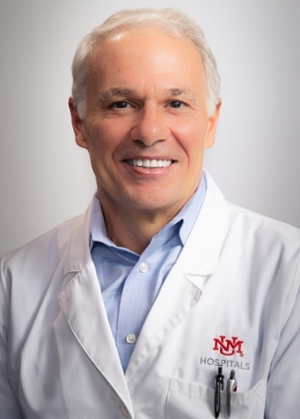Catching breast cancer early can give women the best chance of beating the disease. Mammograms help to catch breast cancer in its early stages – usually before a woman even feels any symptoms – and can afford women the most treatment choices.
But Dario Marchetti, PhD, thinks mammograms can’t find cancer soon enough. He and his team are developing tools to find cancer cells in the blood, before the primary tumor grows large enough to see on a mammogram, and before tumors can grow in other parts of the body. Their work was reported in the June 19, 2020, edition of Cancers.
Marchetti is a professor of Molecular Medicine and Pathology at The University of New Mexico School of Medicine. At the UNM Comprehensive Cancer Center, he studies how cancer tumors spread.
Tumors return in about one third of the 275,000 women in the United States who are diagnosed with breast cancer each year, Marchetti says. Only about 20% of these women live for more than five years after the tumors reappear. “When cancer recurs,” Marchetti says, “it recurs with a vengeance.”
 Breast cancer tumors, like most solid tumors, shed cells into the blood stream. When these cells reach other parts of the body, they can start new tumors there. Marchetti says that this process, called metastatic seeding, starts two to four years before diagnosis — before the primary tumor gets large enough to be seen on a mammogram.
Breast cancer tumors, like most solid tumors, shed cells into the blood stream. When these cells reach other parts of the body, they can start new tumors there. Marchetti says that this process, called metastatic seeding, starts two to four years before diagnosis — before the primary tumor gets large enough to be seen on a mammogram.
Because the primary tumor grows twice as fast as the seeded tumors, Marchetti and his team want to look for tumor cells in the blood before new tumors can start. When they perform a procedure called a liquid biopsy, finding tumor cells in blood is far from easy. Circulating tumor cells, Marchetti says, “are incredibly rare – just one tumor cell for every billion normal cells in the blood.”
Most circulating tumor cells die within 24 hours of entering the blood stream, Marchetti says. “They are also far more fragile than normal cells.”
Tumor cells don’t look or behave like each other, either. “Cancer is heterogeneous,” Marchetti says. So just because a cell doesn’t look or behave like the billion other cells doesn’t mean that it’s a cancer cell capable of starting a new tumor.
To identify cancer cells that would eventually lead to tumors in other organs, Marchetti and his team developed a way to test each cell in a blood sample. In their work, the scientists took cells from women with breast cancer and grew them in mice that had no immune systems. Then, they collected cell samples from many different organs within each mouse’s body.
After separating the human tumor cells from the mouse cells, Marchetti and his team compared the cancer cells from all of their organ samples. What they found was that some tumor cells hid within the body. These dormant cells found places where they could live peacefully, and they didn’t start new tumors. Others, the team found, started tumors that quickly grew.
Marchetti and his team compared the genes and proteins within the different tumor cells. They found that the genes in the dormant cells differed greatly from the genes in the cells that spawned new tumors.
“Our work has clinical implications to personalize drugs, define inhibitors – or both – for precise clinical interventions,” he says.
But Marchetti cautions that blood tests for breast cancers – and personalized treatments based on these tests – are still a long way off. This research, he says, only further proves the validity of liquid biopsies.
Before liquid biopsies can be used routinely, more research is needed in animals with working immune cells, and then in many people, over a period of several years and with several types of cancer. And, liquid biopsies must be able to tell doctors where the cancer is in the body.
Still, Marchetti hopes that cancers may one day be found, and treatments personalized, before the first tumor can even be seen.
UNM Comprehensive Cancer Center
The University of New Mexico Comprehensive Cancer Center is the Official Cancer Center of New Mexico and the only National Cancer Institute-designated Cancer Center in a 500-mile radius.
Its more than 136 board-certified oncology specialty physicians include cancer surgeons in every specialty (abdominal, thoracic, bone and soft tissue, neurosurgery, genitourinary, gynecology, and head and neck cancers), adult and pediatric hematologists/medical oncologists, gynecologic oncologists, and radiation oncologists. They, along with more than 600 other cancer healthcare professionals (nurses, pharmacists, nutritionists, navigators, psychologists and social workers), provide treatment to 65% of New Mexico’s cancer patients from all across the state and partner with community health systems statewide to provide cancer care closer to home. They treated almost 15,000 patients in more than 100,000 ambulatory clinic visits in addition to in-patient hospitalizations at UNM Hospital.
A total of nearly 1,855 patients participated in cancer clinical trials testing new cancer treatments that include tests of novel cancer prevention strategies and cancer genome sequencing.
The more than 123 cancer research scientists affiliated with the UNMCCC were awarded $38.2 million in federal and private grants and contracts for cancer research projects. Since 2015, they have published nearly 1000 manuscripts, and promoting economic development, they filed 136 new patents and launched 10 new biotechnology start-up companies.
Finally, the physicians, scientists and staff have provided education and training experiences to more than 500 high school, undergraduate, graduate, and postdoctoral fellowship students in cancer research and cancer health care delivery.